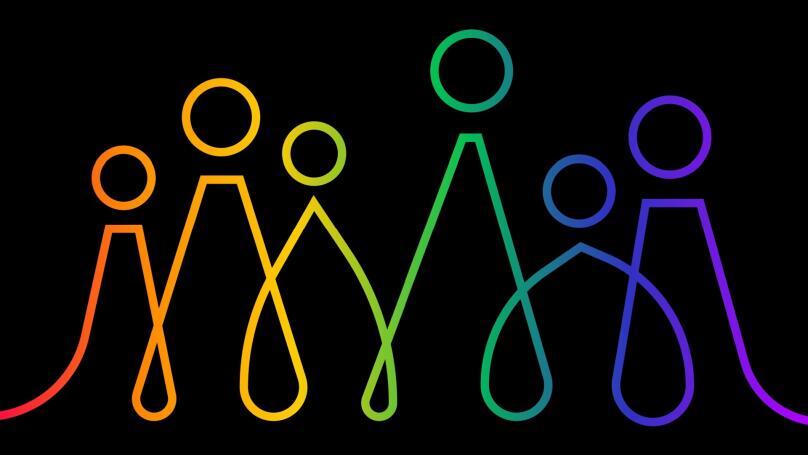Diversity, Equity, and Inclusion

What diversity, equity, and inclusion are about
Diversity, equity, and inclusion, or DEI, is the modern trend of including diverse people in business management. For example, people from national minority groups, sexual minorities, the disabled, and individuals of various religious affiliations. This policy seeks to diversify business and unite the entity's team. According to the McKinsey survey, DEI helps stabilize the company's internal processes and strengthen its position in competitive markets.
The diversity, equity, and inclusion concept describes the three most important values that many organizations are adopting today to meet the needs and provide opportunities for professional fulfillment for people from all walks of life. Although the inclusion and diversity trend emerged over a decade ago, it is gaining momentum in the business environment.
Why diversity, equity, and inclusion are important
Diversity aims to create a healthy, non-toxic, and supportive environment for various people to cooperate and interact, regardless of ethnicity, sexual preferences, and mental and physical characteristics. So, the DEI values contribute to creating a space that brings people together not despite but because of their peculiarities.
Moreover, such diversity in the company enables building a team of top professionals, leading experts, and industry leaders. Uniting competent professionals of various backgrounds, ages, and gender identities helps to generate new and daring ideas actively.
DEI is important because the values of diversity are about improving employee working conditions and safety, and care is not only about their professional interests but also about their personal well-being, health, and mental state. This approach contributes to higher retention rates in companies that embrace the DEI values because employees are highly loyal to such management. There is also a higher trust between rank-and-file employees and the heads of divisions, units, or departments. This indicator is assumed to depend primarily on the management and the relationships it builds with its subordinates. According to the study Build Trust in Diversity, Equity, and Inclusion Commitments, if top bosses state that they are committed to DEI and ensuring diversity but fail to deliver, about 40% of employees will consider quitting.
Moreover, studies suggest that companies following the DEI policy do not only actively attract and retain the most talented and promising specialists but also successfully implement innovations and maximize the performance of each individual and team as a whole. The McKinsey Center has run several studies: Why Diversity Matters, Achievement through Diversity, and Diversity Wins: How Inclusion Matters. The researchers analyzed over 1,000 large companies in 15 countries and found a clear correlation between business performance and diversity. So, the DEI principles help improve economic performance, increase labor productivity, and enhance employee motivation and engagement in all internal processes.
It is a proven fact that DEI-committed entities are more flexible and mobile; they can respond faster to the challenges of the outside world and meet the most unexpected needs of their target audience. They gradually expand and erase their boundaries through diversity and openness in their workforce.
Diversity, equity, and inclusion in the workplace

Although the closely intertwined DEI values form the basis of a unified approach, they are still different. For example, diversity means a diverse workforce with employees of differing views, opinions, and attitudes. In addition, diversity in the workplace is comprised of:
-
gender diversity, i.e., a workforce equally composed of men, women, and non-binary persons;
-
age diversity, or employing different generations;
-
ethnic diversity, when employees of various nationalities, backgrounds, and cultural traditions work together;
-
physical or neural diversity, i.e., employing people with health peculiarities, disabilities, and mental problems.
Each diversity type creates a free and open environment for discussion and debate, contributing to the most important type of diversity - ideas, opinions, and thoughts. Ultimately, diversity leads to sound decision-making based on employees' diverse experiences. After all, we know that the more opinions and points of view are considered when creating a product, the better and more popular it will be.
Equity implies fair treatment of all employees, regardless of their characteristics. However, equity does not mean that all professionals should be treated similarly. On the contrary, fairness means considering each person's uniqueness and treating them according to their circumstances.
In turn, inclusion is what supports and promotes diversity and equality. In business, inclusion means creating a work environment, a corporate culture, and team relationships where diverse opinions, voices, and ideas not only have a place but are welcomed, valued, and encouraged. An inclusive workplace is where everyone, regardless of their background and identity, feels supported to express themselves and their talents and to contribute to a common cause. Although some companies require their workers to follow certain etiquette rules, behavior models, and dress codes, inclusiveness does not prevent employees from expressing themselves.
In an inclusive environment, all individuals should be able to work effectively and comfortably despite their health conditions or disabilities. So, inclusion in the workplace fosters an atmosphere of cooperation, support, respect, and acceptance of both themselves and each other.
Diversity, equity, and inclusion in education
The DEI values are being actively adopted in all spheres of life, particularly education. For example, UNESCO has prepared a special plan for developing general and higher education up to 2030. According to the document, education should be accessible to the widest possible range. It manifests the principles of diversity, equity, and inclusion, i.e., ensuring equal access to education for all children, adolescents, and students, including those with special educational needs.
The DEI principles in education are realized through a learning system in which everyone interested can study in general education institutions regardless of their physical, social, emotional, mental, linguistic, intellectual, and other characteristics. However, creating special conditions to make it a reality is essential-adapting curricula, using innovative teaching methods, modifying achievement assessment methods, etc.
Along with DEI, other principles on which today's educational system should be based are freedom of action, critical thinking and creativity development, honesty and ethics, striving for social responsibility, and cooperation instead of competition.
Diversity, equity, and inclusion in marketing

We are witnessing the increasing popularity of diversity, equity, and inclusion values among consumers. For example, an Adobe survey shows that 61% of Americans value diversity, equity, and inclusion in advertising. Moreover, 38% of the respondents said they would trust a brand's products more if it applied the DEI principles in its operations.
Buyers increasingly make their choices based on diversity, equity, and inclusion. The 5W Public Relations study also strongly correlated consumer values and a brand's position. The vast majority of millennials, 83%, believe their favorite brands must share their personal views. For example, the same study showed that over 70% of consumers are willing to pay more for a product if they are sure that a certain percentage of its price will be donated to charity.
So, diversity and equity are becoming a leading marketing trend. Consumers are no longer willing to support and purchase products from companies whose positions they consider unethical or inhumane. Creating an inclusive culture allows them to connect with the brand and feel their individuality and importance. This is why most video ads and PR campaigns feature people of various ethnicities, genders, and physical characteristics. In other words, any content should be acceptable to all people. To this end, different population groups are researched, unique inclusive designs are created, and products are optimized for people with disabilities, for example, through improving websites, voice search, etc.
We shouldn't overlook the so-called tone of brand voice. This is one of the ways of communicating the true values and philosophy of the company. One of the ways to declare the brand's worldview is by building a diverse team. For this purpose, working teams are built to include men and women of various ages and ethnic and religious backgrounds. Such a diverse team will be able to factor in all the subtleties and nuances in producing a particular good and enable the creation of a product uniting people regardless of their specifics.
DEI in marketing also means a deep connection with customers, prioritizing their needs and demands. This requires active interaction with the target audience in their natural setting, attention to the challenges faced by various groups of people, and immersion in their culture.
Under these circumstances, if a company follows the DEI principles in marketing, it communicates its solidarity with people of various ethnicities and religions, sexual minorities, individuals with health issues, and other groups. This is how companies unite a large and diverse audience around themselves and their products-they speak the same language, support them, and help meet their needs with their products.
How to promote diversity, equity, and inclusion in a company

For companies wishing to incorporate DEI values in their operations, there are seven main areas to focus on. First of all:
- Identify skills and talents your organization lacks
You need to do an in-depth analysis of all internal processes, the performance of the team as a whole, and each worker. The data collected will provide a clear picture of what your company lacks. If it has recently suffered a significant drop in the youth segment sales, you should consider a vacancy for a young novice specialist with advanced creative thinking. If, on the contrary, the company is losing its older audience, then 50+ specialists should be brought in to share their take on the issue and to help find a way to resolve it most effectively.
- Make it clear in job openings that applicants can be people with health conditions, disabilities, and other physical and mental impairments
It is not enough to mention that the company follows diversity principles. Clarify what this means for your organization: not only accepting people of various ages and genders but also sexual minorities, the disabled, and so on. Moreover, it is also essential to encourage inclusive leadership, i.e., the presence of disabled individuals in leadership positions in the organization.
- Be fair to all workers and ensure equal opportunities for everyone
This is the key rule in embracing diversity values: ensuring that every worker is assessed fairly and equitably and given equal rights and opportunities. According to McKinsey's survey on inclusion and equality in the workplace, respondents from all walks of life face certain barriers to employment and later in the workplace. For example, female respondents from ethnic and racial minorities face extra challenges. Diversity values are intended to eliminate these barriers or at least reduce the risks of their occurrence and minimize their impact.
- Create and improve requisite working conditions for all employees
By this, we don't mean just ramps for the disabled but also creating a healthy and positive psychological climate in the team, well-being programs, in-company psychotherapy, and other team-building tools. Harvard Business Review study proved the need for team building. It established that increased employee happiness translates into 37% sales growth, 31% higher labor productivity, and 19% higher task fulfillment accuracy. Pretty good results, you'll agree.
- Encourage collaboration, not competition
Team members shouldn't just work side by side but also listen to each other's opinions, respect different points of view, and provide help and support when needed. Only when workers feel their colleagues' respect and support can they freely share their opinions and experiences and propose daring ideas without fear of being rejected or judged. Cooperation translates into higher labor efficiency for each person and a higher performance for the whole team. Moreover, the McKinsey survey on inclusion and equity in the workplace mentions that nearly 40% of respondents said they had refused to work or decided to quit because of a sense of non-inclusion.
- Be open to innovation and communicate your values
A successful brand is more than just products created under a certain logo. A company gains recognition thanks to its philosophy, which sets it apart from competitors and maintains a certain image in the business environment. It also provides the benefits of working for a particular entity or consuming goods of a particular brand. So, you should not conceal your company's mission. On the contrary, communicate your values, declare your goals, and follow certain principles! Talk about it!
It is equally important to be open to innovation and ready for the volatility of today's markets. If a business sticks to traditional values, it risks missing out on many current trends and losing considerable profits. So, it is essential to constantly improve existing products and experiment and invent, thus creating additional opportunities for the company employees to realize their talents.
- Prevent aggression and hostility in the team
More than 80% of the respondents in the McKinsey survey on inclusion and equity in the workplace said they had experienced aggression in the workplace. Aggression compromises performance and efficiency, so taking the initiative and facilitating the team's adoption of the DEI values is imperative. For example, organizations should embrace meritocracy-the governance principle whereby the most capable and talented workers, irrespective of their social and ethnic background, financial wealth, and gender, occupy leadership positions.
How to measure diversity, equity, and inclusion in a team

Step 1. Define what diversity, equity, and inclusion mean to you
There is no one-size-fits-all approach. The diversity and inclusion specifics vary across organizations depending on their structure and operations. So first, define your ideal workforce, who should be in your team, and what values to embrace.
Step 2. Compare ideal concepts with reality
Once you have defined the DEI concepts specifically for your entity, analyze the team relationships and see if these principles are followed. Consider whether all team members are as equal as they should be. Does everyone have access to the opportunities and the resources? Has anyone experienced prejudice or restrictions on their freedoms? It would be fair to ask your employees these questions and ask them to make an impartial assessment of their relationships with the top managers and the team. Thus, one diversity indicator is the workers' satisfaction. To determine it, you can use a simple tool - a survey. Find out whether, in your employees' opinion, everyone has the same chances for career growth. Do any of the specialists enjoy privileges? In what cases and how do others react to this? Are salaries fair enough? And so on.
Step 3. Study the results of exit interviews
An exit Interview is the final conversation with an employee leaving the company. Getting feedback and learning about the worker's challenges in their position is essential, and then using the information to improve your business. That is why it is important to clarify at each exit interview whether the diversity values are followed. This way, you will get a frank opinion about how diversity and equity principles are realized.
Step 4. Gather third-party feedback
Remember that if your business truly follows the DEI principles, it's visible even from the outside. So, talking to your partners and regular customers about them is a good idea. Ask them to share honest feedback and opinions about your company's activities. This will allow you to explore the matter further and analyze different points of view on the importance of diversity.
Step 5. Monitor key indicators regularly
Remember that DEI values must be upheld and communicated to your team, audience, partners, and other stakeholders. Regular employee surveys collecting and analyzing feedback will allow you to identify difficulties or gaps in realizing diversity and inclusion. So, you should regularly analyze and draw interim conclusions, comparing results monthly or quarterly, for example. This way, you'll see how DEI is fairing in your company. Given the actively changing external factors and market conditions, it is equally important to analyze diversity constantly and revise its specifics in a particular business.
Step 6. Share progress with your team
Reporting to your colleagues and subordinates on your entity's efforts is important. This will ensure transparency in your relationships and promote trust and cooperation. Even if the results are not immediately positive, share them with your workers, outline your action plan, and then invite them to develop their initiatives to strengthen DEI in the team. This way, the staff will see that the management has a genuine interest and willingness to improve their working conditions.
Conclusions
Emphasis on diversity in the business environment and other areas of activity has led to major societal changes. The DEI concept is now a popular modern trend in business development and an effective strategy for increasing employee performance, motivation, and engagement. International researchers have established that diversity, equity, and inclusion values positively impact a company's reputation in the media environment and all internal business processes, employee creative thinking, product quality, and demand. So, adopting and adhering to the DEI principles will be an important step towards improving your organization, in-team relations, and the outcomes of your common efforts.























